|
|
|
Sort Order |
|
|
|
Items / Page
|
|
|
|
|
|
|
| Srl | Item |
| 1 |
ID:
159717
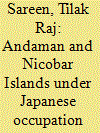

|
|
|
|
|
| Publication |
New Delhi, Life Span Publishers and Distributors, 2018.
|
| Description |
xii, 270p.; ill.hbk
|
| Standard Number |
9788193418857
|
|
|
|
|
|
|
|
|
|
|
|
Copies: C:1/I:0,R:0,Q:0
Circulation
| Accession# | Call# | Current Location | Status | Policy | Location |
| 059431 | 954.0359/SAR 059431 | Main | On Shelf | General | |
|
|
|
|
| 2 |
ID:
053277
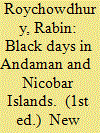

|
|
|
|
|
| Edition |
1st ed.
|
| Publication |
New Delhi, Manas Publications, 2004.
|
| Description |
293p.hbk
|
| Standard Number |
8170491835
|
|
|
|
|
|
|
|
|
|
|
|
Copies: C:1/I:0,R:0,Q:0
Circulation
| Accession# | Call# | Current Location | Status | Policy | Location |
| 048405 | 954.030096564/ROY 048405 | Main | On Shelf | General | |
|
|
|
|
| 3 |
ID:
126139
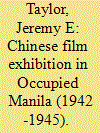

|
|
|
|
|
| Publication |
2013.
|
| Summary/Abstract |
This paper explores the nature of film exhibition amongst the Chinese community in Manila during the Japanese Occupation of that city. Based on advertisements and film listings published in the Chinese-language press of the day (as well as on pre-war records concerning commercial Chinese entertainment in the Philippines), it explores the continuities in film exhibition practice undertaken by various theatre operators within the Binondo area of Manila both before, during, and after the war. The paper suggests not only that such practices represented a quite different trajectory from that experienced in other parts of Occupied Manila, but also that a more thorough exploration of the Manila Chinese during wartime-one which goes beyond questions of mere collaboration and/or resistance-will encourage us to question some of the assumptions that underpin recent scholarship about this community.
|
|
|
|
|
|
|
|
|
|
|
|
|
|
|
|
| 4 |
ID:
117475
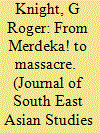

|
|
|
|
|
| Publication |
2012.
|
| Summary/Abstract |
Between 1945 and 1965, what may be broadly defined as the politics of sugar in Indonesia passed through several critical stages. The industrial manufacture of sugar had begun in the Netherlands Indies in the mid-nineteenth century, but after a slump during the 1930s Depression, the industry virtually went into abeyance during the Japanese Occupation (1942-45). After the war, the years of struggle for Merdeka! (freedom) also saw a partial revival of the industry, which continued through national revolution and independence (1949) through to an incremental nationalisation in the late 1950s. Developments in the sugar industry culminated in massacre, rather than merdeka, however. The campaign against the PKI (Indonesian Communist Party) which began in 1965 resulted in the murder of labour unionists and peasant activists associated with the sugar industry. This paper traces the course of events from Merdeka to massacre, focusing on the sugar industry of East Java's Brantas valley. Its themes, however, relate to the industry in Java as a whole, and the question of why the commodity production of sugar came to be so deeply embroiled in the politics of the new republic.
|
|
|
|
|
|
|
|
|
|
|
|
|
|
|
|
| 5 |
ID:
117476
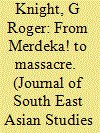

|
|
|
|
|
| Publication |
2012.
|
| Summary/Abstract |
Between 1945 and 1965, what may be broadly defined as the politics of sugar in Indonesia passed through several critical stages. The industrial manufacture of sugar had begun in the Netherlands Indies in the mid-nineteenth century, but after a slump during the 1930s Depression, the industry virtually went into abeyance during the Japanese Occupation (1942-45). After the war, the years of struggle for Merdeka! (freedom) also saw a partial revival of the industry, which continued through national revolution and independence (1949) through to an incremental nationalisation in the late 1950s. Developments in the sugar industry culminated in massacre, rather than merdeka, however. The campaign against the PKI (Indonesian Communist Party) which began in 1965 resulted in the murder of labour unionists and peasant activists associated with the sugar industry. This paper traces the course of events from Merdeka to massacre, focusing on the sugar industry of East Java's Brantas valley. Its themes, however, relate to the industry in Java as a whole, and the question of why the commodity production of sugar came to be so deeply embroiled in the politics of the new republic.
|
|
|
|
|
|
|
|
|
|
|
|
|
|
|
|
| 6 |
ID:
143863
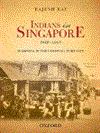

|
|
|
|
|
| Publication |
New Delhi, Oxford University Press, 2014.
|
| Description |
xxix, 325p.: tableshbk
|
| Standard Number |
9780198099291
|
|
|
|
|
|
|
|
|
|
|
|
Copies: C:1/I:0,R:0,Q:0
Circulation
| Accession# | Call# | Current Location | Status | Policy | Location |
| 058577 | 959.5700491411/RAI 058577 | Main | On Shelf | General | |
|
|
|
|
| 7 |
ID:
110223
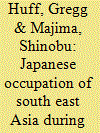

|
|
|
|
|
| Publication |
2011.
|
| Summary/Abstract |
This article reviews recent Japanese- and English-language publications to assess scholarly interchange between the two languages and the effects on South East Asia of Japan's Second World War occupation. The economic and social impact on Borneo, Malaya and Singapore of the Japanese interregnum was devastating. In Burma and Indonesia, military training given by the Japanese fundamentally shaped the post-war order. The authors find surprisingly little cross-over between those writing in Japanese or in English and argue that greater academic exchange, possibly facilitated through translation, would enhance understanding of wartime South East Asia.
|
|
|
|
|
|
|
|
|
|
|
|
|
|
|
|
| 8 |
ID:
175550
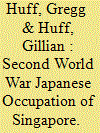

|
|
|
|
|
| Summary/Abstract |
Japan's Second World War occupation of Singapore was marked by acute shortages of food and basic consumer goods, malnutrition, rampant black markets and social breakdown. We argue that the exploitation of Singapore was extreme and fully accorded with pre-war Japanese policy. Japan used Singapore mainly as a communications centre and port to ship Indonesian oil. Mid-1943 attempts to add manufacturing to the city's role had limited success. Acquiescence of Singaporeans to Japanese rule was a notable aspect of occupation. While part of the explanation is that the occupation was a reign of terror, the economics of shortage conferred on the Japanese considerable leverage in maintaining social control.
|
|
|
|
|
|
|
|
|
|
|
|
|
|
|
|
| 9 |
ID:
138498
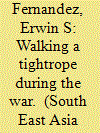

|
|
|
|
|
| Summary/Abstract |
Part of a larger, in-depth biographical study of the Filipino writer and diplomat Leon Maria Guerrero (1915–1982), this article deals with Guerrero’s wartime activities. Having studied under American Jesuits at the Ateneo de Manila in the 1930s, Guerrero became critical of the Americans during the Japanese occupation. As an officer in the Military Intelligence Service in Bataan, he was disillusioned with America and was forcibly employed by the Japanese. This article explores the reasons behind Guerrero’s transformation during the Japanese occupation. After the war, a People’s Court was established to try charges of collaboration. Guerrero was never indicted in the court and, as one discerning observer, Tomas Santiago, noted, he was able to escape trial despite having served as propagandist for the Japanese Hodobu or Department of Information. Was Guerrero a traitor? And if so, whom did he betray? This article addresses these questions in the context of how Guerrero responded during his work as a radio commentator to the challenges posed by the Japanese occupation – akin to walking a tightrope. The article analyses selected and preserved radio commentaries in addition to taking note of oral and historical accounts. It concludes with a consideration of the wider ramifications of the politics of collaboration in the context of American policy towards the Philippines.
|
|
|
|
|
|
|
|
|
|
|
|
|
|
|
|
|
|
|
|
|